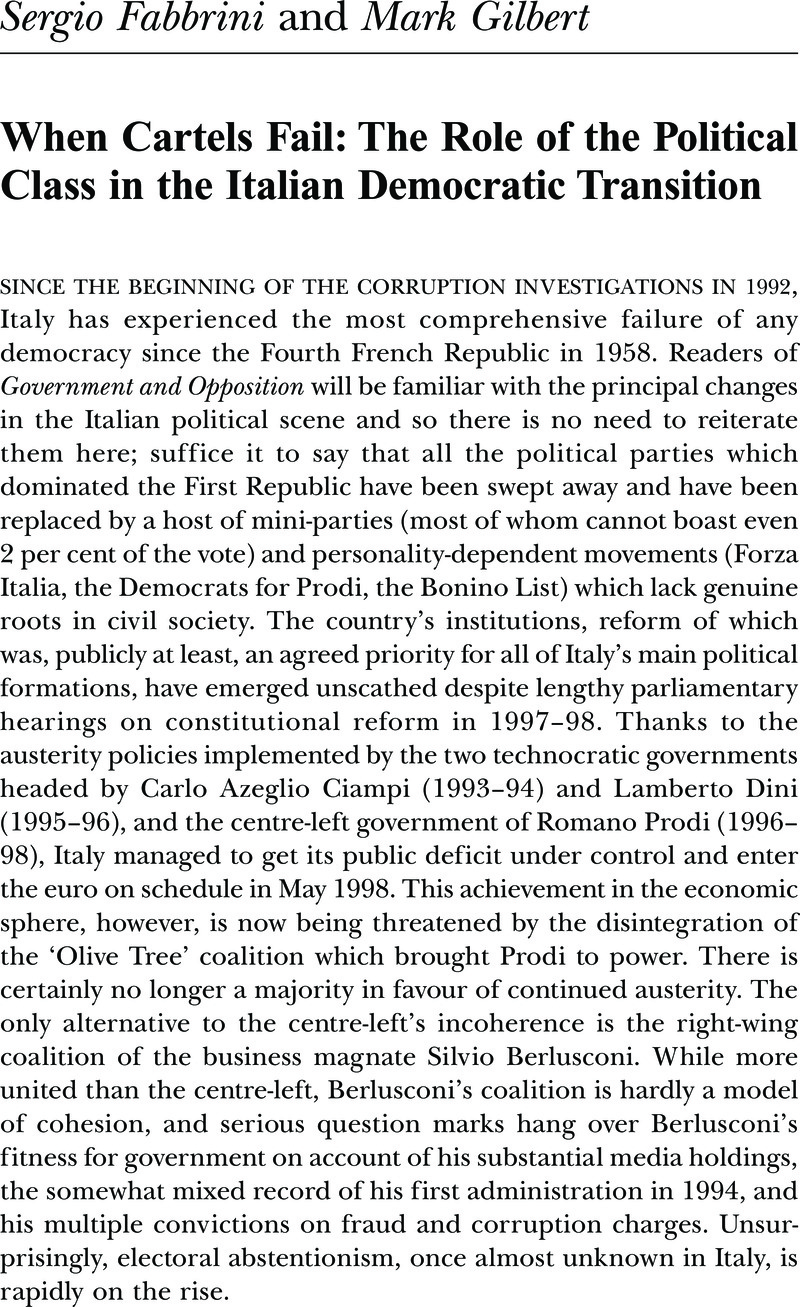Article contents
When Cartels Fail: The Role of the Political Class in the Italian Democratic Transition
Published online by Cambridge University Press: 28 March 2014
Abstract

- Type
- Original Articles
- Information
- Copyright
- Copyright © Government and Opposition Ltd 2000
References
1 The reference is to Lijphart, Arend, Democracies: Patterns of Majoritarian and Consensus Government in Twenty-One Countries, New Haven, Yale University Press, 1984 CrossRefGoogle Scholar. A book on the same theme that deals with Italy at greater length is Fabbrini, Sergio, Quale Democrazia? L’Italia e gli altri, 3rd edn, Bari, Laterza Press, 1999 Google Scholar.
2 On this point, see Scala, Vincent Della, ‘Frustrating Change: Constitutional Politics in Post-War Italy’, in Russell, P. and Galligan, B. (eds), Redesigning the State II, Toronto, Toronto University Press, 1999 Google Scholar. See also, Vassallo, S., Il governo dei partiti in Italia (1943–1993), Bologna, Il Mulino, 1994 Google Scholar.
3 Pasquino, Gianfranco, ‘Italy: The Twilight of the Parties’, Journal of Democracy, 5:1 (1994), pp. 18–29 CrossRefGoogle Scholar.
4 See Pasquino, Gianfranco, ‘Party Government in Italy: Achievements and Prospects’, in Katz, R. S. (ed.), Party Government: European and American Experiences, Berlin, De Gruyter, 1987, pp. 202–42Google Scholar.
5 See the still useful book by Palma, Giuseppe La, Surviving Without Governing. The Italian Parties in Parliament, Berkeley, Cal., University of California Press, 1977 Google Scholar.
6 See Sartori, Giovanni, ‘Techniche decisionali’, Elementi di teoria politica, Bologna, Il Mulino, pp. 359–93Google Scholar.
7 Ignazi, Piero, Dal PCI al PDS, Bologna, Il Mulino, 1992 Google Scholar.
8 For the development of the Italian state’s industrial holdings, see De Cecco, M. and Pedone, A., ‘Le istituzioni dell’economia’, in Romanelli, Raffaele (ed.), Storia dello Stato Italiano, Rome, Donzelli, 1995, pp. 253–300 Google Scholar. Another major recent work is Cassese, S., La Nuova costituzione economica, Bari, Laterza, 1995 Google Scholar.
9 This point is insisted upon in Cafagna, Luciano, La grande slavina, Venice, Marsilio, 1995. See especially pp. 115–37.Google Scholar
10 See, Fabbrini, Sergio, ‘Italy: The Crisis of an Oligarchical State’, in McCarthy, P. and Jones, E. (eds), Disintegration or Transformation? The Crisis of the State in Advanced Industrial Societies, New York, St Martin’s, 1995, pp. 65–83 Google Scholar.
11 A point stressed by Bufacchi, Vittorio and Burgess, Simon, Italy since 1989, London, Macmillan, 1998 Google Scholar.
12 See Diamanti, Ilvo and Mannheimer, Renato, Milano a Roma: guida all’Italia elettorale del 1994, Rome, Donzelli, 1994 Google Scholar.
13 See, on this point, the similar analyses of Furlong, Paul, Modern Italy: Representation and Reform, London, Croom Helm, 1994 CrossRefGoogle Scholar, and McCarthy, Patrick, The Crisis of the Italian State, New York, St Martin’s, 1995 Google Scholar, especially chs 8–10.
14 See Gilbert, Mark, The Italian Revolution: The End of Democracy, Italian Style? Boulder, Colo., Westview, 1995 Google Scholar, especially ch. 7, for a fuller discussion of this point. The same argument is implicit in McCarthy, The Crisis of the Italian State.
15 The reference is to: Pasquino, Gianfranco and McCarthy, Patrick, The End of PostWar Politics in Italy: The Landmark 1992 Elections, Boulder, Colo., Westview Press, 1993 Google Scholar.
16 Hine, David, ‘Italian Political Reform in Comparative Perspective’, in Gundle, S. and Parker, S., The New Italian Republic: From the Fall of the Berlin Wall to Berlusconi, London, Routledge, 1995, p. 314 Google Scholar.
17 Such analyses have even reached a popular audience in Italy. See, for example, ‘Diciotto ragioni per rimanere ultimi’, L’Espresso, 8 January 1998, pp. 106–25. This special report went into great detail about Italy’s deficiencies when compared with its European partners.
18 See, on this point, Fabbrini, Sergio, ‘Il governo Prodi: un primo bilancio istituzionale’, Il Mulino, XLVII: 4 (1998), pp. 657–72Google Scholar.
19 The social and economic origins of the Lega Nord have been brilliantly treated in Diamanti, Ilvo, La Lega: geografia, storia e sociologia di un nuovo soggetto politico, Rome, Donzelli, 1993 Google Scholar.
20 Cacciari, Massimo, ‘Manifesto del Nord Est’, MicoMega, 1, 1998, pp. 14–19 Google Scholar. See also, Bull, Anna and Gilbert, Mark, Wind from the North: The Lega Nord and the Politics of Secession, London, Macmillan, forthcoming 2000 Google Scholar.
21 See, Hellman, Stephen, ‘Italy’ in Kesselman, M. et al., European Politics in Transition, Boston, Houghton Mifflin, pp. 335–464 Google Scholar.
22 For a discussion of D’Alema’s political ideas see Gilbert, Mark, ‘In Search of Normality: The Political Strategy of Massimo D’Alema’, Journal of Modern Italian Studies, 3:3 (1998), pp. 307–17CrossRefGoogle Scholar.
23 See Vassallo, Salvatore, ‘Il federalismo sedicente’, Il Mulino, XLVI: 4 (1997), pp. 694–707 Google Scholar.
24 For an English language summary of the Bicamerale, see Gilbert, Mark, ‘Transforming Italy’s Institutions: The Bicameral Committee on Institutional Reform’, Modern Italy 3:1 (1998), pp. 49–66 CrossRefGoogle Scholar. In Italian, see Pasquino, Gianfranco, ‘Dal premeriato forte al semipresidenzialismo debole’, in Il Mulino, XLVI: 4 (1997), pp. 685–93Google Scholar and Morlino, Leonardo and Sartori, Giovanni, L’occasione mancata, Bari, Laterza, 1998 Google Scholar.
25 Readers of Italian should consult Travaglio, Marco, ‘La bozza Boato tradota in italiano’, MicroMega, 5, 1997, pp. 51–69 Google Scholar. All the documents produced by the Bicamerale are on the web on the homepage of the Italian parliament.
26 See Fabbrini, Sergio, ‘Change without Institutional Transformation. What Can We Learn from the Italian Crisis in the 1990s?’, International Political Science Review, 20:1 (2000)Google Scholar.
- 3
- Cited by




